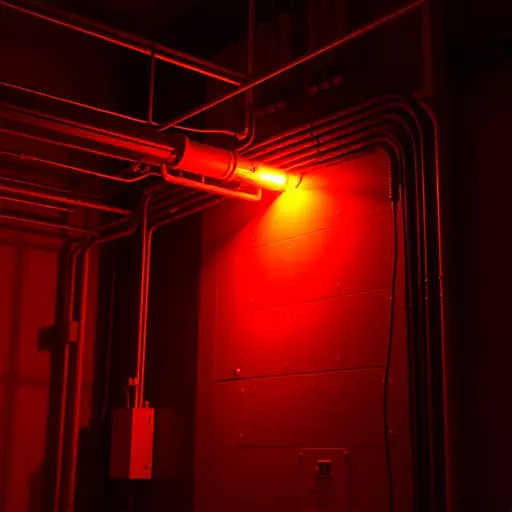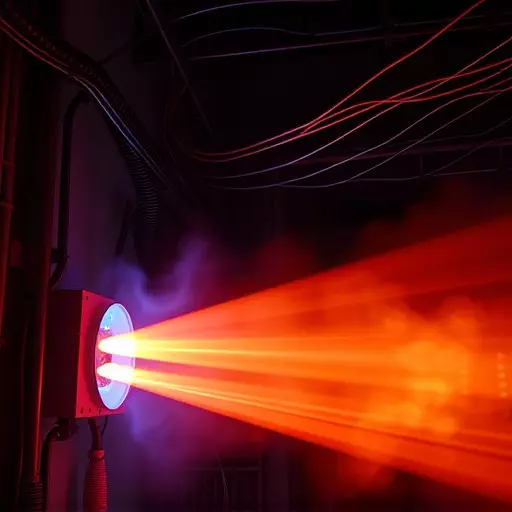The arc flash study process is a critical component of electrical hazard analysis, aimed at mitigating risks from arc flash events in industrial settings. It involves understanding incident energy, calculated as total energy released (in kJ/m²) during an arc, to determine potential hazards and adhere to arc flash safety standards. Electrical hazard analysis assesses factors like voltage, current, and proximity to quantify incident energy levels, crucial for selecting appropriate personal protective equipment (PPE) and implementing safety measures. By following International Standards and utilizing techniques like IEEE 1584, professionals can ensure compliance, protect workers, and minimize arc flash risks in high-risk environments.
In the realm of electrical safety, understanding incident energy is paramount. This powerful force, released during an arc flash event, can cause severe injuries and damage. Our article guides you through the intricate world of incident energy calculation, beginning with a foundational grasp on the concept. We explore the step-by-step arc flash study process, delve into electrical hazard analysis for risk identification, and navigate international arc flash safety standards. By combining these elements, we equip professionals to mitigate risks effectively.
- Understanding Incident Energy: A Basic Concept
- The Arc Flash Study Process: Unraveling the Basics
- Electrical Hazard Analysis: Identifying Risks and Vulnerabilities
- International Standards for Arc Flash Safety
- Calculating Incident Energy: Formulas and Factors
- Impact of Incident Energy on Human Safety
- Implementing Safety Measures: Post-Calculation Steps
Understanding Incident Energy: A Basic Concept
Incident energy is a fundamental concept in understanding and mitigating electrical hazards, particularly during an arc flash event. It represents the total energy released in kilojoules per square meter (kJ/m²) when an electrical arc occurs. This energy can cause severe burns, damage equipment, and even lead to fatalities if not controlled effectively. The arc flash study process involves a thorough evaluation of potential hazards, including incident energy calculations, to determine the appropriate personal protective equipment (PPE) and safety measures for workers in high-risk environments.
Electrical hazard analysis plays a crucial role in identifying risks associated with electrical systems. By assessing factors such as voltage, current, arc duration, and proximity to the arc, professionals can estimate incident energy levels. These calculations are essential for adhering to arc flash safety standards, ensuring the well-being of employees, and maintaining compliance with industry regulations. Understanding incident energy is a critical step in developing comprehensive strategies for electrical system safety.
The Arc Flash Study Process: Unraveling the Basics
The Arc Flash Study Process is a critical component of electrical hazard analysis, designed to assess and mitigate risks associated with potentially dangerous arc flash events. This comprehensive study involves a systematic evaluation of an electrical system’s design, operation, and potential failure modes, with specific focus on arcing faults. It’s a structured approach to ensuring compliance with arc flash safety standards and promoting the well-being of workers in industrial settings.
The process begins by gathering detailed information about the electrical system, including equipment specifications, circuit diagrams, and operating procedures. Through careful analysis, engineers identify potential arc flash hazards, considering factors like voltage, current, and clearance distances. Advanced calculations are then employed to determine incident energy levels, which serve as a critical metric for assessing risk. This data is used to implement appropriate safety measures, such as personal protective equipment (PPE) guidelines, system upgrades, or architectural modifications, ensuring that the workplace remains safe and compliant with industry-recognized arc flash safety standards.
Electrical Hazard Analysis: Identifying Risks and Vulnerabilities
Electrical Hazard Analysis plays a pivotal role in incident energy calculation and arc flash study process. It involves meticulous identification of potential risks and vulnerabilities associated with electrical systems. This comprehensive analysis delves into evaluating every aspect of an electrical setup, focusing on components like live parts, power levels, and possible human interactions. By employing established arc flash safety standards, professionals can quantify the energy released during an arc flash incident, enabling them to implement appropriate protective measures.
This process isn’t merely a one-time task but requires regular updates as electrical systems evolve over time. It’s crucial for ensuring compliance with relevant regulations and maintaining a safe working environment. Effective electrical hazard analysis forms the backbone of effective incident energy calculation, ultimately fostering arc flash safety standards that protect workers and critical infrastructure.
International Standards for Arc Flash Safety
The International Standards for Arc Flash Safety provide a comprehensive framework to mitigate electrical hazards, particularly focusing on arc flash incidents. These standards guide organizations through an intricate arc flash study process, which involves a thorough assessment of electrical systems and equipment to identify potential risks. By employing advanced analysis techniques, such as Electrical Hazard Analysis (EHA), professionals can accurately calculate incident energy, a critical parameter in determining the appropriate personal protective equipment (PPE) for workers.
Adhering to arc flash safety standards ensures that workplaces are equipped with the necessary tools and knowledge to handle electrical hazards effectively. This includes understanding the principles of arc flash protection, conducting regular inspections, and maintaining up-to-date safety protocols. By following these international guidelines, organizations can significantly reduce the risks associated with arc flashes, fostering a safer environment for employees and enhancing overall operational efficiency.
Calculating Incident Energy: Formulas and Factors
Calculating incident energy is a critical component of any thorough arc flash study process and electrical hazard analysis. This essential step involves determining the amount of energy released during an arc flash event, which can vary widely based on factors like voltage, current, duration, and gap distance. Several formulas are used to calculate incident energy, each tailored to different scenarios. For instance, the IEEE 1584 standard provides a detailed approach that considers the characteristics of electrical equipment and operating conditions to predict incident energy levels accurately.
Understanding these formulas and the underlying factors is crucial for adhering to arc flash safety standards. By conducting meticulous calculations, engineers can identify potential hazards, determine appropriate personal protective equipment (PPE), and implement necessary measures to mitigate risks associated with high-energy arcs. This proactive approach not only enhances workplace safety but also ensures compliance with industry best practices.
Impact of Incident Energy on Human Safety
The impact of incident energy on human safety is a critical aspect often scrutinized during an arc flash study process. Incident energy, which represents the kinetic energy of electrically charged particles, can cause severe injuries or even fatalities in cases of electrical hazard analysis. It’s a key factor in understanding and mitigating risks associated with high-voltage systems.
Arc flash safety standards, as part of a comprehensive electrical hazard analysis, are designed to protect workers from these dangers. By accurately calculating incident energy levels, professionals can implement appropriate control measures, such as improved equipment design, personal protective equipment (PPE), or engineering controls, thereby enhancing arc flash safety in industrial environments.
Implementing Safety Measures: Post-Calculation Steps
After accurately calculating incident energy, the next crucial step is to implement safety measures based on the results. This involves a comprehensive understanding of electrical hazard analysis and adherence to arc flash safety standards. The first action is to conduct an in-depth review of the findings from the arc flash study process. This includes identifying high-risk areas, evaluating existing protective equipment, and assessing control measures already in place.
By integrating these insights, organizations can develop a tailored strategy to mitigate risks. This might include upgrading electrical systems, implementing enhanced personal protective equipment (PPE), or redesigning work procedures to minimize exposure to electrical hazards. Regular audits and training sessions are essential to ensure that safety protocols remain effective and that all personnel are prepared to handle potential arc flash events.


